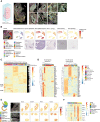Spatially resolved whole transcriptome profiling in human and mouse tissue using Digital Spatial Profiling
- PMID: 36100434
- PMCID: PMC9712633
- DOI: 10.1101/gr.276206.121
Spatially resolved whole transcriptome profiling in human and mouse tissue using Digital Spatial Profiling
Abstract
Emerging spatial profiling technology has enabled high-plex molecular profiling in biological tissues, preserving the spatial and morphological context of gene expression. Here, we describe expanding the chemistry for the Digital Spatial Profiling platform to quantify whole transcriptomes in human and mouse tissues using a wide range of spatial profiling strategies and sample types. We designed multiplexed in situ hybridization probes targeting the protein-coding genes of the human and mouse transcriptomes, referred to as the human or mouse Whole Transcriptome Atlas (WTA). Human and mouse WTAs were validated in cell lines for concordance with orthogonal gene expression profiling methods in regions ranging from ∼10-500 cells. By benchmarking against bulk RNA-seq and fluorescence in situ hybridization, we show robust transcript detection down to ∼100 transcripts per region. To assess the performance of WTA across tissue and sample types, we applied WTA to biological questions in cancer, molecular pathology, and developmental biology. Spatial profiling with WTA detected expected gene expression differences between tumor and tumor microenvironment, identified disease-specific gene expression heterogeneity in histological structures of the human kidney, and comprehensively mapped transcriptional programs in anatomical substructures of nine organs in the developing mouse embryo. Digital Spatial Profiling technology with the WTA assays provides a flexible method for spatial whole transcriptome profiling applicable to diverse tissue types and biological contexts.
© 2022 Zimmerman et al.; Published by Cold Spring Harbor Laboratory Press.
Figures





References
-
- Brady L, Kriner M, Coleman I, Morrissey C, Roudier M, True LD, Gulati R, Plymate SR, Zhou Z, Birditt B, et al. 2021. Inter- and intra-tumor heterogeneity of metastatic prostate cancer determined by digital spatial gene expression profiling. Nat Commun 12: 1426. 10.1038/s41467-021-21615-4 - DOI - PMC - PubMed
MeSH terms
LinkOut - more resources
Full Text Sources
Medical
Molecular Biology Databases
